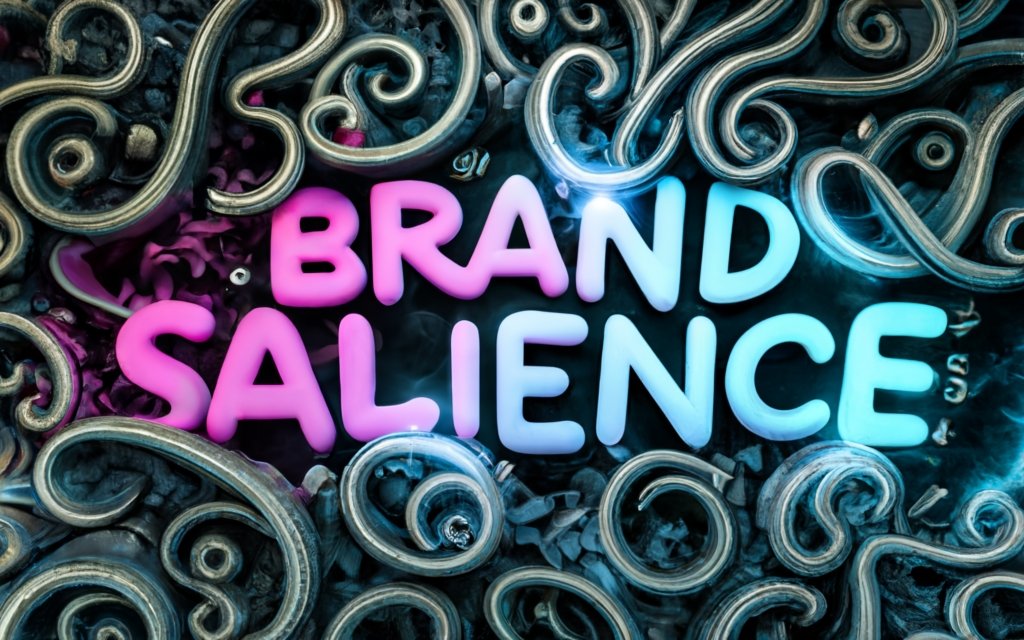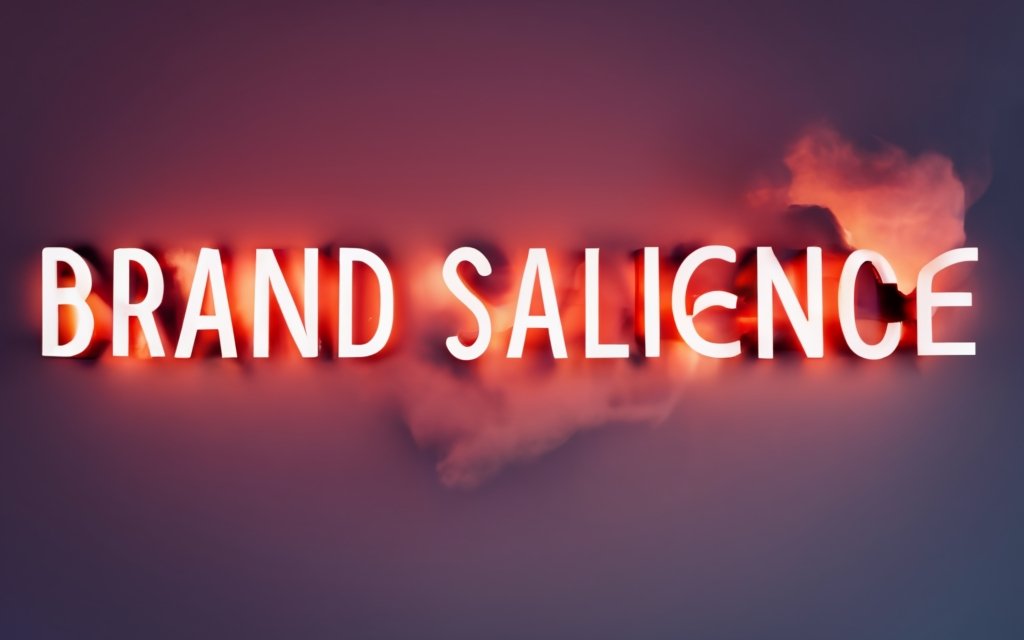Earning those coveted spots in the front of consumers’ minds is every brand’s dream. But climbing to the top takes creativity, vigilance, and forging real connections. This guide covers everything from boosting your brand salience to tracking top of mind awareness and beyond.
Learn the secrets of iconic top of mind brands and how to join their ranks.
What is Brand Salience and Why Does it Matter?
For companies trying to make their mark in a crowded marketplace, capturing consumer awareness and preference is an ongoing challenge. While general brand awareness is important, there is an additional concept that is critical for brands to understand: brand salience.
Defining Brand Salience
Brand salience refers to how easily and how often a brand comes to mind for consumers in buying situations. It measures the degree to which your brand registers mentally when customers are making purchasing decisions.
Meaning of Salience in Marketing
Salience is about prominence and how noticeable or memorable something is. In psychology, salience refers to things that stand out and capture attention.
When applied to marketing, brand salience indicates how strongly your brand stands out in the buyer’s mind compared to competitors. High salience means your brand jumps to the forefront when a customer is considering a purchase.
Brand Salience Definition
More formally, brand salience is defined as the propensity for a brand to be thought of or recalled by a consumer during purchase occasions. It indicates how front-of-mind your brand is for customers as they make choices.
The higher your salience, the more likely you’ll be selected. Brands with strong salience enjoy top-of-mind status in their category. Their brand is instinctively thought of first by shoppers.
What is Brand Salience and Why is it Important?
Brand salience matters because it directly impacts sales and revenue. When your brand is top-of-mind, it gets chosen more often. Brands with high salience convert more shoppers because they are the default, go-to option.
Gaining salience sharpens your competitive edge. The more your brand is considered and selected, the faster you’ll grow your market share. High salience fuels growth by driving preference, conquest sales from competitors, and repeat purchases.
Additionally, salience creates a buffer against competitors. Shoppers don’t think too hard when a top-of-mind brand easily comes to mind. This automatic preference makes it harder for lesser known brands to sway customers.
Brand Salience vs. Brand Awareness
While related, brand salience and brand awareness are distinct. Brand awareness focuses on overall visibility and familiarity. In contrast, salience is about memory and preference when buyers are ready to purchase.
How They Differ
Brand awareness is about breadth of exposure. It asks – how many people know about your brand? Salience is about depth of connection. It looks at how strongly your brand is embedded in consumer memory.
For example, most people have heard of small brands like Sun-Maid or Vlasic. But dominant brands like Welch’s and Heinz come to mind first for most shoppers when buying jams or pickles. The category leaders have higher salience despite similar awareness.
Role of Salience in the Customer Journey
Brand awareness drives initial discovery and interest. Salience determines which brands make the final consideration set and receive preference when shoppers have buying intent.
Awareness gets you into the initial consideration set. Salience makes you the primary choice when consumers reach the decision point. Strong awareness plus high salience is the optimal brand combination.
Ways to Measure Brand Salience
Since salience reflects subconscious memory, directly measuring it can be challenging. But several methods help gauge a brand’s current salience.
Brand Surveys
Asking consumers directly which brands come to mind when shopping in specific categories is the most direct technique. Open-ended questions allow you to quantitatively measure top-of-mind mentions.
Focus Groups
In-depth qualitative research provides context on why certain brands earn preference. Discussions reveal emotional connections driving salience.
Brand Equity Studies
Equity research incorporates brand salience measurement into modeling brand strength. Advanced analytic techniques map salience levels relative to competitors.
Grasping brand salience is key for emergence, survival, and leadership in competitive markets. Monitoring it provides an important barometer of marketing effectiveness and brand growth. Give your brand the salience assessment it deserves.
This covers an overview of brand salience – what it means, how it differs from awareness, its role in customer choice, and ways to measure it. Let me know if you would like me to modify or expand this section in any way. I will wait for your feedback before continuing.

Understanding Top of Mind Awareness for Brands
Beyond general brand awareness, the pinnacle for companies is achieving top of mind status – being the first brand that comes to consumers’ minds. Top of mind awareness confers key advantages that brand managers should understand.
What is Top of Mind Awareness in Marketing?
Top of mind awareness means your brand pops into the consumer’s mind first when they think about your product category. It indicates your brand has the dominant mindshare in the market.
Definition of Top of Mind Awareness
More formally, top of mind awareness (TMA) refers to the percentage of consumers who think of your brand first when asked to name brands in your category. The higher your TMA, the more prominent your brand’s positioning in memory.
TMA quantifies your brand’s mental availability. It measures how easily recallable your brand is when prompted with a category cue or consumer need. Leading brands aim for ownership of their category with supreme top of mind strength.
Front of Mind vs Back of Mind Brands
High TMA puts your brand figuratively in the front of the consumer’s mind, meaning it will be thought of rapidly when needed. Brands with poor TMA are pushed back further in memory, only recalled after other category players.
Front of mind brands get chosen by default without much thought. Back of mind players must fight to be remembered and selected later in the purchase process. You want your brand occupying the top TMA position.
Why is Top of Mind Brand Awareness Crucial for Brands?
Owning the top TMA spot within your niche brings several commercial advantages:
It Drives Growth
When you’re the first brand thought of, you’re more likely to capture the sale. Your products will be preferred through high mental availability and familiarity. Being the TMA leader equals greater revenue.
It Improves Marketing Efficiency
Top of mind brands don’t have to spend as much defending their position. Their prominence makes marketing easier and more effective overall. TMA leaders gain more traction faster.
It Creates a Competitive Edge
Leading TMA grants your brand pole position from the starting line. You gain an upper hand in consumer perception. Rivals must climb faster and invest more to attempt to knock you from your perch.
Low Awareness Hurts Brands
Without decent awareness, shoppers don’t know your brand exists. And you certainly won’t make it into the consideration set. Brands with poor awareness never get the chance to compete for customers at all.
Top of Mind Marketing Strategies
While a mix of marketing initiatives contributes to TMA, four proven tactics stand out for building robust awareness:
Paid Advertising
Paid ads put your brand directly in front of target consumers frequently. Their controlled reach efficiently hammers home brand messages.
Social Media
Active social profiles keep engaging users with brand content and personality. Followers see your brand often in their feeds.
Content Marketing
In-depth educational and entertaining content gets your brand discovered by people seeking related information. It sticks in their minds for future reference.
Brand Activations
Experiential events and promotions bring the brand to life through sensory interactions. Vivid, immersive brand activations aid TMA.
Shoot for top of mind status to gain a leg up on competitors. Consistently pursue high mental availability by leveraging targeted brand-building activities. Become the brand consumers think of first and enjoy the benefits.
This covers what top of mind awareness means, why it is so important for brand marketers, and tactics to improve a brand’s TMA with consumers. Please let me know if you would like me to modify or expand on this section further. I’m ready to continue with the next section once I receive your feedback.

Techniques to Become a Top of Mind Brand
Building a highly salient brand that enjoys top of mind status takes work. Brands must actively shape how consumers perceive and engage with them over time. Here are proven strategies and best practices to become a leading top of mind brand.
Build Emotional Connections Through Storytelling
At its core, stellar branding is about forging emotional bonds with consumers. Leverage the power of stories to foster relationships and memories that elevate your brand.
Leverage Nostalgia and Shared Experiences
Nostalgic throwback campaigns remind audiences of fond memories and tap into sentimental emotions. Associating your brand with happier times generates affinity and salience.
For example, Coca-Cola’s enduring holiday campaigns evoke cozy memories of family gatherings. The brand intertwines itself with those nostalgic moments and good vibes.
You can also develop creative narratives that connect with common experiences your audience relates to today. Capture shared cultural truths that help your brand resonate.
Convey Your Brand Values and Personality
Infuse your brand identity with a distinct perspective and voice. Clearly convey what your brand stands for to attract your tribe.
Brands like Nike and Apple have forged deep loyalty through brand stories that tap into consumer aspirations and mindsets. Find your version of their “Just Do It” or “Think Different” ethos.
Leverage storytelling across channels to bring your brand personality to life. From social content to campaigns to packaging, ensure consistency in showcasing your brand point of view.
Prioritize Brand Consistency Across Channels
In pursuing salience, brand consistency is king. Familiarity comes from recognizable repetition of your core visual and verbal brand assets.
Maintain Uniform Brand Assets and Messaging
Have clear brand guidelines to govern usage of trademarks, logos, imagery, fonts, tone of voice, etc. Provide assets and templates to internal teams and external partners.
From your website to product packaging to advertising, ensure your distinctive brand identifiers are instantly recognizable regardless of context. Consistent assets and messaging drive memorability.
Craft a Cohesive User Experience Across Touchpoints
The customer journey traverses multiple interactions with your brand. Connect these micro-moments through consistent UX and brand Reinforce your top of mind presence.
Optimizing cross-channel journeys eliminates friction and immerses users in your brand world. Each touchpoint is an opportunity to delight and engage.
Commit to Ongoing Innovation and Creativity
A static brand is a forgotten brand. Continually evolve your positioning and marketing to stay fresh and exciting in consumers’ minds.
Don’t Let Your Brand Become Stale or Outdated
Regularly assess consumer perceptions via market research. Know when you risk losing relevance or coming across as stale.
Address shifts in consumer preferences or demographics with updated branding. Refresh tired visual identities and marketing narratives to reinvigorate interest.
Continually Surprise and Delight Your Audience
Launch new formats, products, and activations that captivate consumers and drive buzz. Set the pace in your category throughnon-stop creativity.
Clever campaigns like Apple’s iconic “1984” Super Bowl ad repeatedly reenergize their brand. Extract more value from successful initiatives through sequels, remixes, and callbacks.
Invest in innovation to keep your brand top of mind over the long haul. Reinvent yourself before competitors force you to.
Optimize Your Marketing Funnel and Brand Experiences
Flawless execution of every brand touchpoint and purchase process inspires loyalty, advocacy, and repeat purchases.
Remove Friction During Research and Purchase
Identify pain points across the funnel – from discovery to consideration to conversion. Eliminate anything slowing users down or causing frustration.
Optimized journeys feel effortless, building affinity for your helpful brand. Checkouts, mobile UX, web forms, and virtual shopping experiences all matter.
Deliver Exceptional Post-Purchase Support
The brand experience continues after the sale. Follow up with helpful resources and superior customer service.
Make returns, exchanges, installation, and other support channels easy and painless. Exceed expectations – send thank you notes, set up product walkthroughs, etc.
Word spreads quickly about brands that go above and beyond. Turn customers into evangelists with best-in-class experiences.
Leverage Influencers and Customer Advocates
Credible voices speaking passionately about your brand make a greater impression than ads ever can. Encourage organic advocacy.
Harness the Power of Word-of-Mouth
Satisfied users sharing authentic stories about your brand drives awareness and sales. Aim for conversations rather than one-way ads.
Seed reviews, testimonials, referrals, and user-generated content. Make it simple for fans to spread the word within their spheres of influence.
Encourage Organic Brand Mentions
When influencers voluntarily showcase your brand because they love it, it signals quality and relevance. Seek out genuine connections.
Provide VIP access to experience your brand, as well as discounts or free product samples to spark interest. Make it worthwhile for influencers to highlight you.
Top of mind status doesn’t happen accidentally. But the payoff is immense. Follow these principles to become a beloved household name brand consumers instinctively remember and crave.

Monitoring and Maintaining Top of Mind Status
Achieving top of mind brand status is an ongoing endeavor. Brand relevance and salience fluctuate based on evolving market dynamics. Proactive monitoring and agility keep your brand in the spotlight.
Regularly Survey Customers and Prospects
Check in with your audience frequently to measure brand performance and uncover shifts in perceptions.
Measure Key Brand Health Metrics Over Time
Leverage surveys to track metrics like awareness, consideration, preference, associations, and satisfaction.
Look for changes across demographics and buyer journeys. Identify potential weaknesses and optimize accordingly.
Ask About Competitors
Include questions about competitor brands to benchmark your performance and watch for threats.
Signs of declining brand equity, value perceptions, or loyalty indicate a need for intervention to defend your position.
Stay on Top of Market Trends and Competitor Moves
Vigilantly scan your business environment for anything impacting your brand relevance.
Monitor Changes in Audience Preferences
Evolving consumer needs and tastes can quickly leave brands behind. Notice emerging demands to realign your brand accordingly.
Refresh messaging and experiences regularly to show customers you understand them and have solutions for where they are now.
Preemptively Address Potential Threats
Keep tabs on competitors and watch for new innovations or challenger brands threatening disruption.
Develop counterstrategies before interlopers siphon away mindshare. Slow reaction times can be fatal.
Keep Innovating and Refreshing Your Brand
Frequently reinvent your brand experience to combat familiarity and nostalgia fatigue.
Avoid Brand Fatigue Through Strategic Reinvention
Even beloved brands risk going stale eventually. Recognize when you need a revamp to become fresh again.
Strategically evolve the brand before it becomes tired and consumers move on. Time reboots well to renew interest.
Balance Consistency With Novelty
Preserve core visual and verbal brand equity through transformations. Change supporting elements for novelty.
Updates should feel familiar yet new. Introduce innovations while maintaining continuity on foundational traits.
Leverage Analytics Across Channels
Data analysis guides optimal allocation of branding investments to sustain salience.
Identify Your Highest-Impact Brand Touchpoints
Measure branding KPIs across media platforms and experiences. Double down on high-performing channels.
Reduce spending on laggards showing diminishing returns. Align budget and activity to ROI.
Continuously Optimize Campaigns and Experiences
Dig into performance trends over time. Quickly adapt creative, messages, placements for better results.
Nothing stays static for long. Use insights to keep branding strategy on target in an evolving landscape.
Build a Community Around Your Brand
Loyal brand fans become your best advocates, organically amplifying your message and visibility.
Foster Lasting Brand Affinity and Loyalty
WOW customers consistently to emotional bonds beyond transactions. Spotlight shared values and identity.
Devoted brand communities drive recurring revenue while providing built-in focus groups for research.
Encourage Natural Brand Advocacy
Empower passionate customers to be brand ambassadors. Arm them with assets to showcase your brand on their own initiative.
Cultivate relationships with loyalists and influencers. They will proudly push you into the spotlight unprompted.
The top of mind quest demands agility and commitment. Measure, listen, optimize, and engage. Take the steps to sustain mindshare and preference.
Please provide any feedback to help me refine this section before I move on to the next one. I’m ready to incorporate additional details as needed.

Top of Mind Brand Examples
The most salient brands achieve an exalted place in the consumer psyche. They dominate their respective categories as the default, go-to choice when shoppers think of related products. Here are 4 stellar examples of top of mind brands and how they’ve claimed that mental real estate.
Coca-Cola
Coca-Cola is undoubtedly the quintessential top of mind soda brand. According to surveys, Coke owns a majority 61% share of top of mind awareness for carbonated soft drinks.
The brand cemented its dominance through ubiquitous advertising over decades. Coca-Cola’s cheerful holiday marketing and sponsorship of major events like the Olympics ingrained it deeply into American culture. Sipping a Coke became synonymous with celebratory or festive occasions.
Coca-Cola also made its iconic Contour bottle a recognizable brand avatar. The unique bottle shape stands out instantly on store shelves or in consumers’ hands, reinforcing mental availability.
Between the cheerful imagery, cultural imprint, and distinctive assets, Coca-Cola has become inextricably linked to positive memories and emotions surrounding soda. Just seeing the dynamic ribbon logo or signature red can mentally transports consumers to happier times.
Even consumers who personally prefer Pepsi still tend to think of Coke first when cola is mentioned. Coca-Cola exhibits brand salience mastery.
Nike
In the athletic apparel world, Nike reigns supreme as consumers’ top of mind brand. The Swoosh logo is globally synonymous with sports and fitness.
Like Coca-Cola, Nike gained early traction through connecting with athletes and sport’s biggest events. Sponsoring stars like Michael Jordan fused the brand with aspirational achievement in consumers’ minds.
Bold, empowering campaigns like “Just Do It” framed Nike as more than just gear – it represented mentality and lifestyle. The brand continually drops buzzy product launches and attention-grabbing ads to stay front and center.
Distinctive trademarks like the Swoosh, “Just Do It”, and Air Jordan cement Nike’s brand identity. Consumers instantly picture Nike seeing any of those assets. In surveys, Nike leads closest competitor Adidas in unaided brand awareness by over 25%.
Through cultural relevance and relentless innovation, Nike has imprinted itself as the default brand for athletic apparel.
Apple
Tech giant Apple dominates not just sales, but mindshare. It enjoys top of mind awareness across multiple product categories.
The Apple brand is synonymous with intuition, imagination, and innovation. Clean aesthetics and sleek minimalism provide visual differentiation from competitors.
Apple maximizes salience by selling an experience beyond the hardware. From packaging to interfaces, everything is thoughtfully crafted to be intuitive and empowering. The legendary Genius Bar provides exceptional support.
The brand continually churns out category-redefining products enveloped in anticipation and hype. iPad reveals, AirPod drops, and iPhone launches seize public attention.
Consumers don’t just use Apple devices – they proudly join the Apple community. The brand cultivates serious loyalty, with fans eagerly snapping up the latest innovations sight unseen.
Apple sits firmly implanted as the pinnacle of consumer electronics thanks to unparalleled brand equity and salience.
Starbucks
When most people need a coffee shop fix, Starbucks springs to mind first. Surveys show the coffee giant beats out rivals as consumers’ top of mind brand for coffee houses.
Starbucks cemented its leadership through rapid expansion, establishing cafes seemingly on every corner. Convenient locations put the brand top of mind when craving coffee nearby.
Customization like special milk options and flavor shots made the Starbucks experience highly personalized. Their app further increased convenience through mobile ordering and payment.
Playful marketing assets like the Siren logo and quirky drink names reinforced approachability. In-store smells of coffee and baked goods made locations irresistible.
By elevating coffee from mere beverage to an indulgent experience, Starbucks secured its status as the dominant coffee purveyor in consumers’ minds and lives.
These remarkable brands show that attaining top of mind awareness takes creativity, innovation, and forging authentic connections. Their marketing and experiences make them unforgettable. Let their examples inspire your own path to the top.
This covers some top brands that have achieved top of mind status in their respective categories. Please provide any feedback to help refine this section before I finalize the full article draft. I’m ready to incorporate additional details as needed.
Key Takeaways on Achieving Top of Mind Brand Awareness
Becoming a top of mind brand takes creativity and commitment, but pays immense dividends. Here are the key lessons for dominating your category:
- Brand salience means your brand is mentally accessible and preferred during purchasing occasions. High salience makes you the default choice.
- Top of mind awareness quantifies your brand’s dominance. It’s the percentage who think of you first when naming category brands.
- Build indelible emotional connections through nostalgic, values-driven stories and experiences.
- Consistent brand assets and touchpoints reinforce memorability. Don’t deviate from your equity.
- Commit to regular brand reinvention and innovation. Delight your audience with the unexpected.
- Fix pain points across the customer journey – remove all friction from researching to repurchasing.
- Monitor brand metrics and listen to consumers continuously. Optimize based on insights.
- Cultivate brand advocates who passionately showcase you to their networks.
Achieving top of mind status takes relentless creativity and vigilance. But the effort pays off through preference, growth, and profits. Keep these principles in mind on your brand’s climb to the top.
Frequently Asked Questions
Q: What is brand salience?
A: Brand salience refers to how easily and how often a brand comes to consumers’ minds during purchase situations. It measures how prominent your brand is in the buyer’s mindset when they are deciding between options in your category.
Q: How does brand salience differ from brand awareness?
A: Brand awareness focuses on overall visibility and familiarity. Brand salience specifically measures mental accessibility and preference when consumers have active buying intent. High awareness doesn’t guarantee high salience.
Q: Why is high brand salience important?
A: Leading brand salience drives growth by making your brand the default choice. It gets selected more often when consumers don’t weigh options extensively. High salience also makes marketing more efficient and effective overall.
Q: What does top of mind brand mean?
A: A top of mind brand is the first one a consumer thinks of when asked to name brands in a specific category. It indicates your brand dominates the market mentally over competitors.
Q: How can I measure brand salience and top of mind awareness?
A: Surveys, focus groups, and brand equity studies help gauge salience. Asking consumers outright which brands come to mind first when shopping in certain categories will reveal where you stand.
Q: What are some top of mind brand examples?
A: Iconic top of mind brands include Coca-Cola, Nike, Apple, and Starbucks. They lead their respective categories in consumer mindshare and preference.
Q: How can I improve my brand’s salience and top of mind awareness?
A: Storytelling, consistency, innovation, optimized experiences, influencers, promotions, and advertising all contribute. Monitor metrics and fine-tune initiatives based on insights. Building memorability and connection takes time.
Q: What marketing strategies boost top of mind awareness?
A: Paid ads, social media, content marketing, and brand activations like events help. The key is frequent and creative exposure to your brand in places your target audience spends time.
Q: Why is consistency important for brand salience?
A: Familiarity comes from recognizable repetition of core visual and verbal brand assets. Consistent assets, messaging, and user experience across channels drives memorability.
Q: How do I maintain top of mind status long-term?
A: Continuously monitor your brand health through surveys and research. Keep innovating your brand experience and refresh it before it goes stale. Use analytics to optimize efforts based on ROI.

